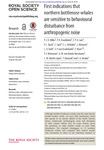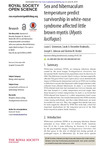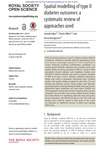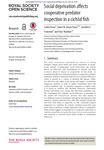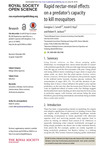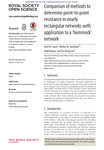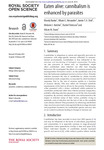Education: Recent submissions
Now showing items 541-560 of 806
-
Balance and coordination after viewing stereoscopic 3D television
(The Royal Society, 2015)Manufacturers and the media have raised the possibility that viewing stereoscopic 3D television (S3D TV) may cause temporary disruption to balance and visuomotor coordination. We looked for evidence of such effects in a ... -
Sub Nyquist artefacts and samplingmoiré effects
(The Royal Society, 2015)Sampling moiré effects are well known in signal processing. They occur when a continuous periodic signalg(x) is sampled using a sampling frequencyfsthat does not respect the Nyquist condition, and the signal-frequencyf ... -
Boundary regularized integral equation formulation of the Helmholtz equation in acoustics
(The Royal Society, 2015)A boundary integral formulation for the solution of the Helmholtz equation is developed in which all traditional singular behaviour in the boundary integrals is removed analytically. The numerical precision of this approach ... -
The missing metric: quantifying contributions of reviewers
(The Royal Society, 2015)The number of contributing reviewers often outnumbers the authors of publications. This has led to apathy towards reviewing and the conclusion that the peer-review system is broken. Given the trade-offs between submitting ... -
First indications that northern bottlenose whales are sensitive to behavioural disturbance from anthropogenic noise
(The Royal Society, 2015)Although northern bottlenose whales were the most heavily hunted beaked whale, we have little information about this species in its remote habitat of the North Atlantic Ocean. Underwater anthropogenic noise and disruption ... -
Consistent individual differences in haemolymph density reflect risk propensity in amarine invertebrate
(The Royal Society, 2015)While the literature on consistent individual differences in correlated suites of physiological and behavioural traits is steadily growing for vertebrates, invertebrates have received less attention. The few studies that ... -
Position dependent hearing in three species of bushcrickets
(The Royal Society, 2015)A primary task of auditory systems is the localization of sound sources in space. Sound source localization in azimuth is usually based on temporal or intensity differences of sounds between the bilaterally arranged ears. ... -
Sex and hibernaculum temperature predict survivorship inwhite-nose syndrome affected little brownmyotis
(The Royal Society, 2015)White-nose syndrome (WNS), an emerging infectious disease caused by the novel fungus Pseudogymnoascus destructans,has devastated North American bat populations since its discovery in 2006. The little brown myotis,Myotis ... -
Spatial modelling of type II diabetes outcomes
(The Royal Society, 2015)With the rising incidence of type II diabetes mellitus (DM II) worldwide, methods to identify high-risk geographical areas have become increasingly important. In this comprehensive review following Cochrane Collaboration ... -
Social deprivation affects cooperative predator inspection in a cichlid fish
(The Royal Society, 2015)The social environment individuals are exposed to during ontogeny shapes social skills and social competence in group-living animals. Consequently, social deprivation has serious effects on behaviour and development in ... -
Baleen boomand bust
(The Royal Society, 2015)A new, fully dated total-evidence phylogeny of baleen whales (Mysticeti) shows that evolutionary phases correlate strongly with Caenozoic modernization of the oceans and climates, implying a major role for bottom-up physical ... -
Brain nonapeptide levels are related to social status and affiliative behaviour in a cooperatively breeding cichlid fish
(The Royal Society, 2015)The mammalian nonapeptide hormones, vasopressin and oxytocin, are known to be potent regulators of social behaviour. Teleost fishes possess vasopressin and oxytocin homologues known as arginine vasotocin (AVT) and isotocin ... -
Rapid nectar meal effects on a predator’s capacity to kill mosquitoes
(The Royal Society, 2015)Using Evarcha culicivora, an East African jumping spider (Salticidae), we investigate how nectar meals function in concert with predation specifically at the juvenile stage between emerging from the egg sac and the first ... -
Kin selection and polygyny: can relatedness lower the polygyny threshold?
(The Royal Society, 2015)Resources for female breeders. When breeding with a relative, however, such costs may be lessened by indirect fitness benefits through kin selection, while benefits from mutualistic behaviour, such as communal defence, may ... -
Comparison of methods to determine point-to-point resistance in nearly rectangular networks with application to a ‘hammock’ network
(The Royal Society, 2015)Considerable progress has recently been made in the development of techniques to exactly determine two-point resistances in networks of various topologies. In particular, two types of method have emerged. One is based on ... -
Carry over bodymass effect from winter to breeding in a resident seabird, the little penguin
(The Royal Society, 2015)Using body mass and breeding data of individual penguins collected continuously over 7 years (2002–2008), we examined carry-over effects of winter body mass on timing of laying and breeding success in a resident seabird, ... -
Building a responsive teacher: how temporal contingency of gaze interaction influences word learning with virtual tutors
(The Royal Society, 2015)Animated pedagogical agents are lifelike virtual characters designed to augment learning. A review of developmental psychology literature led to the hypothesis that the temporal contingency of such agents would promote ... -
Eaten alive: cannibalism is enhanced by parasites
(The Royal Society, 2015)Cannibalism is ubiquitous in nature and especially pervasive in consumers with stage-specific resource utilization in resource-limited environments. Cannibalism is thus influential in the structure and functioning of ... -
Sexual reproduction with variablemating systems can resist asexuality in a rock–paper–scissors dynamics
(The Royal Society, 2015)While sex can be advantageous for a lineage in the long term, we still lack an explanation for its maintenance with the twofold cost per generation. Here we model an infinite diploid population where two autosomal loci ... -
Emotion recognition deficits in eating disorders are explained by co-occurring alexithymia
(The Royal Society, 2015)Previous research has yielded inconsistent findings regarding the ability of individuals with eating disorders (EDs) to recognize facial emotion, making the clinical features of this population hard to determine. This study ...





